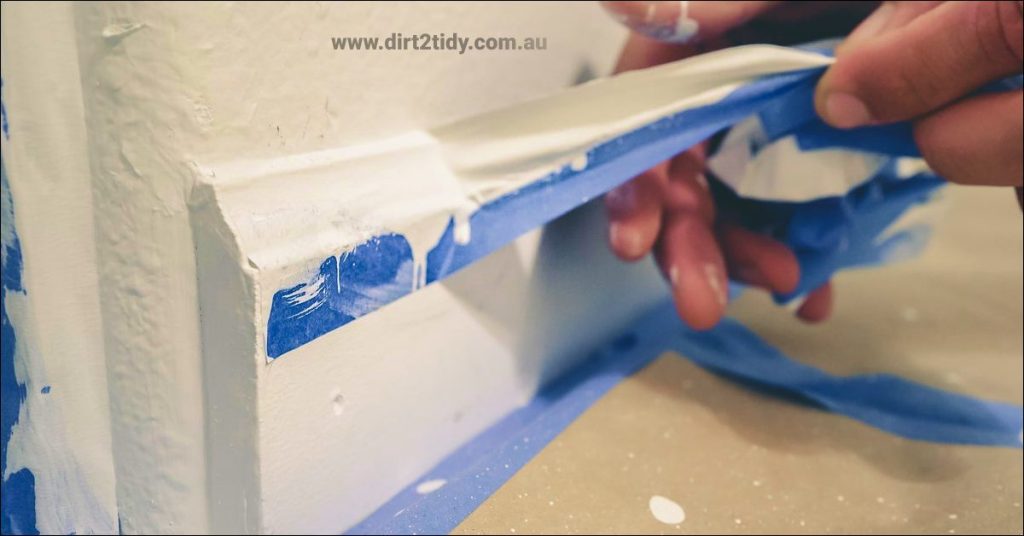If you haven’t thought about the paint job project ahead of time, painting any room may be harder than it seems at first. In fact, the best way to complete wall painting is by following a set of steps.
Even though everyone has their own way of doing things, there is a certain order that needs to be followed in order to get the best results, just like a professional painter.
The Top of the Line
The ceiling should always be the first thing you paint. Because of this, you will be able to paint at least two coats on the surface without worrying about the roller splattering paint everywhere. Over-spray refers to the impact of extra paint being sprayed onto the freshly painted walls.
How to Prepare Your Ceiling for Painting
Before you can achieve a flawless ceiling paint job, proper preparation is crucial. Here’s a step-by-step guide to preparing your ceiling effectively:
- Inspect for Imperfections
Begin by examining the ceiling for any visible cracks or holes. These blemishes need attention to ensure a smooth result. - Patch and Repair
Use a putty knife to apply a suitable filler, like caulk or spackle, to fill in these imperfections. Once the filler has dried completely, take sandpaper to gently sand the area to make it even with the rest of the ceiling. - Tape the Edges
To avoid paint splatters on your walls, carefully apply painter’s tape along the border where the ceiling meets the wall. This will safeguard the walls and create a sharp line. - Ensure a Seamless Surface
These preparatory steps are essential. They create a smooth, clean surface that promotes even paint adhesion, ultimately delivering a professional-grade finish.
By following these steps, you’re setting the foundation for an impeccable paint application that will leave your ceiling looking pristine.
If you want to paint the ceiling, you should always use a roller with a frame made of two arms. The roller can be used well because the frame has two arms that hold it up at both ends.
This gives the same amount of pressure and coverage across the whole width of the roller as it is used. For this application, we would suggest a 12″ perfection medium pile roller and a prestige stainless double arm frame is recommended for ceiling walls.
How Can an Extension Pole Be Beneficial When Painting?
Painting those high-up places on walls and ceilings can be quite the workout. But with an extension pole, the task becomes much more manageable.
- Reach Higher Without a Ladder: Forget about balancing precariously on ladders. An extension pole allows you to reach those ceiling corners with ease.
- Minimize Physical Strain: No more stretching and straining. The pole lets you keep your feet firmly on the ground while still covering high areas effectively.
- Achieve Even Coats: The consistent angle and pressure from the extension pole help ensure that paint is applied smoothly and evenly across all surfaces.
By incorporating an extension pole into your painting toolkit, you’re making the job safer, easier, and more efficient. That’s a win-win for both beginner and seasoned painters alike.
Damn Those Walls
After the ceiling has dried completely, the walls should be cut and rolled with at least two coats of paint. Sticky areas should likewise be primed before the top coats are applied for paint finish.
Related Article: How to remove paint from carpet?
You don’t need to worry if some paint gets on the trim, because this will be taken care of in the next step.
How Caulk and Putty Enhance Your Paint Job
Caulk and putty are essential tools for achieving a professional-quality paint job. They play a crucial role in surface preparation, significantly impacting the overall appearance and durability of the paint finish.
Smooth Out Surfaces
- Fill Imperfections: Before applying paint, it’s vital to address any gaps and cracks in the surface. Caulk and putty effectively fill these imperfections, creating a smooth canvas that ensures even paint application.
- Eliminate Drafts and Moisture: Unsealed gaps can lead to drafts and moisture penetration, which can cause paint to peel or bubble over time. Properly applied caulk and putty can seal these gaps, maintaining the integrity of your paintwork for longer.
Ensure Better Paint Adhesion
- Enhanced Grip: By smoothing out the surface with caulk and putty, you provide the paint with a better surface to adhere to. This means the paint is less likely to flake or chip, resulting in a long-lasting, vibrant finish.
- Even Coverage: A well-prepared surface allows the paint to spread uniformly, reducing the likelihood of streaks or uneven patches that can detract from the aesthetic appeal.
Prevent Future Damage
- Protect Against Elements: Filling in gaps and cracks also protects the underlying structure from environmental damage. By doing this, you prevent potential problems down the road that could affect the paint job’s look and longevity.
In summary, using caulk and putty during the prep stage of painting not only provides a seamless, professional finish but also contributes to the durability and aesthetic of your paint job. These preparatory steps are a small investment of time and effort that yield substantial rewards in the quality and lifespan of your painted surfaces.

The skirting boards
Most people use a semi-gloss or high-gloss finish when painting skirting boards. The next time you paint skirting, try a Perfection pure bristle brush or the Perfection short pile midi roller.
Usually, white paint is used to cover the edges of skirting boards. To make sure the cut line is straight, just put masking tape or painters tape over the area right above the trim. This will get the job done. Just make sure the paint on the walls is totally dry before you start painting on the trim.
The windows and doors frames
The next step is to put up the window and door cleaning. They look a lot like the skirting boards.
Always remember that getting ready is the most important part of this task. Before you put on the final coat, make sure that any nail holes have been filled, that the edges of the frames are properly caulked to the wall, and that any rough edges have been sanded down.

When it comes to painting doors, you have two choices: finish or speed. Both of these options are available for both panel doors and flush doors. When you’re painting a door with panels, you should always start with the panels.
Related article: Do you paint the walls before the wood work?
To get the best finish possible, use a sash brush to get into the curves of the panels for even coverage and a medium-pile mini roller for all of the flat surfaces. You can get both of these brushes.
Now, the most important step in the finishing process is to use the laying off brush. This will give the surface a very smooth and shiny look.
If you don’t mind if the result looks a little bit like orange peel, you should choose the faster option. Again, use a sash brush to make sure you get even coverage in the corners of the panels, but use a short pile mini roller for all the flat areas.

Why is Sanding Between Coats of Paint Important?
Taking the extra step to sand between coats of paint can dramatically enhance the quality and appearance of your finished project. Here’s why it’s crucial:
- Achieving Even Coverage: Sanding helps to eliminate any imperfections from the previous coat. This ensures that the next layer of paint applies smoothly, covering the surface more evenly.
- Smooth Surface: By removing any bumps, dust, or irregularities, sanding results in a silky smooth finish that looks professional and polished. This process is especially important for projects requiring a flawless appearance, like furniture or cabinetry.
- Better Adhesion: Each new coat of paint needs a slightly textured surface to adhere properly. Sanding creates the ideal base, allowing the next layer to bond solidly, reducing the risk of peeling or chipping over time.
- Enhanced Durability: The improved adhesion from sanding not only makes paint less likely to peel but also enhances the overall durability of the finish, ensuring it withstands wear and tear for longer periods.
In summary, sanding between coats isn’t just an optional step—it’s an essential practice that can elevate your painting project from good to exceptional. Whenever possible, take the time to sand lightly between layers for the best results.
Removing the Tape
You should take care of the doors as your last step. When you clean panelled doors, you should use a sash brush and move in the direction of the wood’s grain.
After the hard-to-reach spots have been cut, you can put the finish on the door with either a brush or a regular roller, as long as the door is completely flat. Most of the time, you will only need two coats of paint to cover the trim, walls, and ceiling.
When it comes to painting a room, these are the most important steps to take. If you follow the advice in this article, you can be sure that even the most difficult tasks you have to do will be done quickly and easily. All the hard work was worth it in the end because of what was done.
Proper Cleanup After a Painting Project
Once you finish your painting project, it’s crucial to carry out a thorough cleanup to preserve your tools and maintain an organized workspace.
Step-by-Step Cleanup Guide
- Remove Painter’s Tape Carefully
Gently peel off the painter’s tape at a 45-degree angle to prevent any of your fresh paint from coming off with it. - Clean Your Painting Tools
- Brushes and Rollers: Rinse them under lukewarm water if you’ve used water-based paints. For oil-based paints, use a suitable solvent as directed by the paint manufacturer.
- Paint Trays: Wipe any excess paint with a rag or paper towel before rinsing.
- Reinstall Light Fixtures and Hardware
Return any temporarily removed fixtures or hardware to their original positions to complete your room’s transformation. - Manage Drop Cloths
Shake out any dust or debris outside, and store them properly for future use. - Proper Disposal
- Leftover Paint: Seal it tightly and store in a cool, dry place for touch-ups. For paints you won’t use, check with local regulations for paint disposal or consider donating.
- Waste Materials: Dispose of used paint thinner, rags, and other materials according to local hazardous waste guidelines.
Final Touch
Ensure every tool is cleaned and stored appropriately, preserving their condition for future projects. By tidying up your workspace and dealing responsibly with leftover materials, you contribute to an organized home and a healthier environment.
With these steps completed, your newly painted room is now ready to be enjoyed!
Steps to Prepare a Room for Painting
Preparing a room for painting is a crucial step that ensures the final result is smooth and professional. Here’s a comprehensive guide on how to get your room ready for a fresh coat of paint.
1. Clear and Protect the Space
Begin by removing all furniture from the room. If moving furniture is difficult, gather them in the center and cover them with drop cloths. Lay additional drop cloths on the floor to shield it from paint splatters. Don’t forget to either remove or cover light fixtures and hardware. Clean the surfaces thoroughly to eliminate any dust or cobwebs, creating an ideal environment for painting.
2. Prep the Ceiling
Examine the ceiling for cracks or imperfections. Use a putty knife to fill any holes with appropriate filler, like caulk or spackle. After the filler dries, smooth it using sandpaper to ensure a consistent surface. Apply painter’s tape carefully along the edge where the ceiling meets the walls. This precaution protects the walls from any stray ceiling paint and guarantees a professional finishing touch.
3. Prepare the Walls
After the ceiling is ready, adjust the painter’s tape from the ceiling edge to the walls. Thoroughly clean the wall surfaces to remove any grime. Address any imperfections with caulk or spackle, then sand them to ensure a flawless wall surface. Finally, wipe down the walls with a damp cloth to remove lingering dust—a critical step that helps the paint adhere properly and look uniform.
Taking the time to methodically prepare each part of the room will pay off in the quality and durability of your paint job. This preparation stage sets the foundation for a seamless and visually appealing finish.
Why is it Important to Maintain a Wet Edge While Painting?
Keeping a wet edge while painting is crucial for achieving a smooth, seamless finish on your walls or surfaces. This technique ensures that paint is applied evenly, eliminating unsightly streaks and patchy textures.
When you paint with a wet edge, you consistently overlap the fresh paint with the still-drying paint. This prevents noticeable lines or bands that can occur if the paint dries unevenly.
Here’s why maintaining a wet edge is essential:
- Consistency in Color: A wet edge helps maintain uniform color across the painted surface, as it prevents one section from drying before the adjacent area is painted.
- Smoother Finish: By working with a wet edge, the paint blends more smoothly, resulting in an even texture that’s pleasing to the eye.
- Efficiency: It can also make the process more efficient since you won’t need to revisit and fix areas where the paint didn’t overlap properly.
In short, keeping a wet edge is key to achieving professional-looking results without the hassle of redoing sections or dealing with unsightly marks.
What are the Benefits of Using Drop Cloths During a Painting Project?
When embarking on a painting project, drop cloths are a must-have tool, providing numerous advantages that contribute to a smooth experience.
1. Protection of Surfaces and Belongings
Drop cloths are essential for safeguarding floors, furniture, and other surfaces from paint spills and splatters. Whether you’re painting a ceiling or touching up walls, these protective layers ensure that paint doesn’t stray away from its intended spot, preserving the integrity of your home decor.
2. Ease of Cleanup
One of the most significant benefits of using drop cloths is the ease they bring to the post-project cleanup process. With a proper drop cloth in place, you merely need to gather and remove the cloth, taking with it any drips and debris, thus saving time and effort.
3. Enhanced Safety
During painting, dust and spills can create a slip hazard. Drop cloths add a layer of safety by providing a non-slip surface, especially if you opt for those with rubberized backing. This can be crucial in maintaining a safe and accident-free environment.
4. Organization and Focus
By keeping your area covered and contained, drop cloths help maintain a tidy workspace. This can enhance focus and efficiency during the project since you won’t be distracted by the need to clean up unexpected messes or protect unshielded areas.
5. Versatility and Durability
Drop cloths come in various materials, such as canvas, plastic, and paper, catering to different needs. A canvas drop cloth, for example, is durable and reusable, making it a cost-effective choice for multiple projects, while a lightweight plastic option might be perfect for a one-time job.
Adopting drop cloths into your painting routine not only protects your space but also simplifies the entire process, ensuring a neater, safer, and more efficient project from start to finish.
How to Clean Painting Tools for Longevity and Performance
Maintaining your painting tools not only saves you money but also ensures they deliver consistent results over time. Here’s how to clean and care for them effectively:
1. Brushes
- Remove Excess Paint: After painting, scrape off as much paint as possible using the edge of a paint can or a scraper.
- Rinse: For water-based paints, rinse brushes in warm, soapy water immediately. For oil-based paints, use a solvent like mineral spirits.
- Condition: Once clean, gently reshape the bristles and soak them in a fabric softener solution to keep them supple.
- Dry Properly: Hang brushes with the bristles down to prevent water from draining into the handle, which can loosen the glue holding the bristles.
2. Rollers
- Scrape Off Paint: Use a roller scraper to remove excess paint.
- Soak: For latex paint, soak in warm, soapy water. For oil paints, utilize a matching solvent.
- Rinse and Dry: Rinse thoroughly and spin dry using a spinner or by placing them inside an empty roller tray.
3. Palettes and Paint Trays
- Immediate Clean-Up: Scrape off leftover paint with a putty knife.
- Wipe Down: Use a cloth with the appropriate solvent or soapy water to remove remaining paint.
- Dry: Allow them to air dry completely before storage.
4. Spray Guns
- Flush: Run water or solvent through the gun according to paint type.
- Disassemble for Cleaning: Remove components like the nozzle and cap for a more thorough clean.
- Reassemble and Store: Ensure all parts are dry before putting them back together.
Quick Tips
- Timing is Key: Tackle cleaning as soon as possible after use to prevent paint from hardening and becoming difficult to remove.
- Proper Storage: Store clean tools in a dry, dust-free area to avoid damage and rust.
- Routine Checks: Regularly inspect your tools for damage to address minor issues before they become costly repairs.
By following these steps, you’ll keep your tools in excellent condition, ready for many more projects to come.




